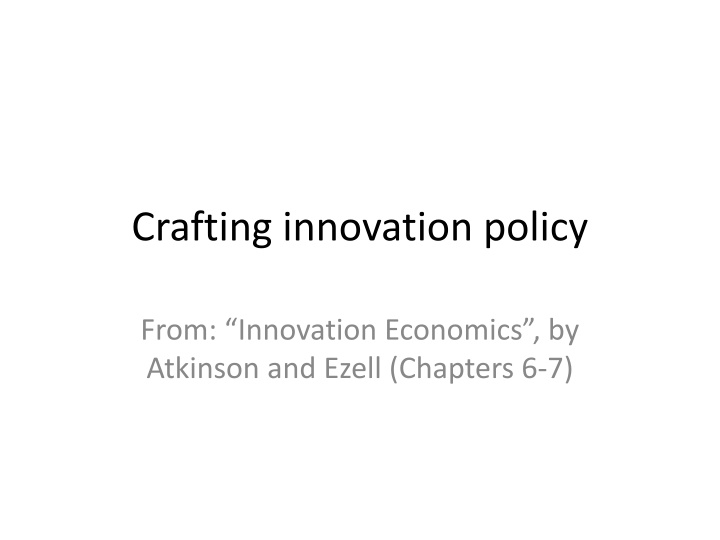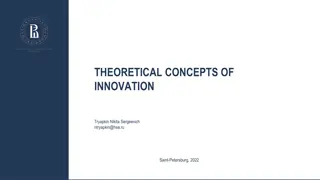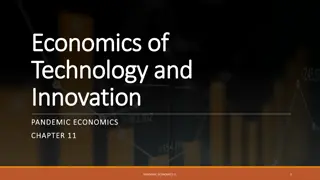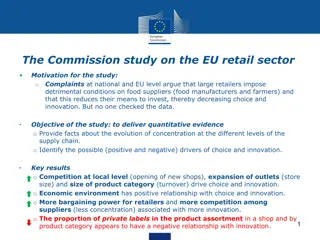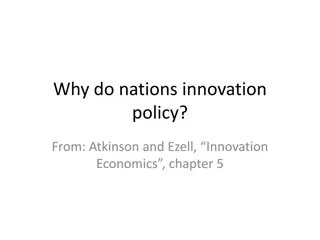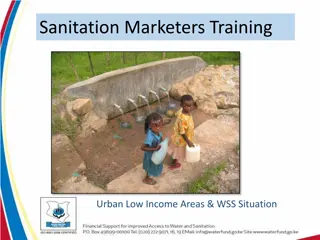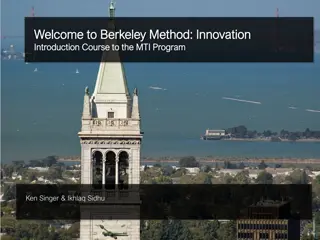Crafting National Innovation Policies: Key Steps and Areas
Crafting effective national innovation policies involves a systematic approach, inspirational vision, and adequate funding. Leading countries follow a three-step process and focus on setting ambitious goals in key technology areas. The concept of Industry 4.0 is driving the fourth industrial revolution through data-driven technologies and interconnected systems.
Uploaded on Feb 25, 2025 | 6 Views
Download Presentation

Please find below an Image/Link to download the presentation.
The content on the website is provided AS IS for your information and personal use only. It may not be sold, licensed, or shared on other websites without obtaining consent from the author.If you encounter any issues during the download, it is possible that the publisher has removed the file from their server.
You are allowed to download the files provided on this website for personal or commercial use, subject to the condition that they are used lawfully. All files are the property of their respective owners.
The content on the website is provided AS IS for your information and personal use only. It may not be sold, licensed, or shared on other websites without obtaining consent from the author.
E N D
Presentation Transcript
Crafting innovation policy From: Innovation Economics , by Atkinson and Ezell (Chapters 6-7)
Leading countries: a three step process 1) Recognizing the need to approach innovation sistematically 2) Broughting attention to the need for innovation to the body politic (inspirational vision, strategy for action, goals and ambitions ) 3) Institutional reforms and adequate funds (tax and tax incentives) needed to implement the policy, even at expenses of other governamental spending or lower taxes for individuals
Seven broad areas that a national innovation policy effort must get right
1) Inspiration (setting ambitious goals) Setting economic goals is not used in the free- market oriented countries, but... Singapore case (1990): S openly declared that it sought to become a world leader in life science, digital media, water/environment industries (eg. Biopolis, biomedical research centre). China case (2006) Long term plan for the development of Science and technology 7 emerging strategic industries, heavy investments
Other nations also openly focused on technology areas and broad industries they seek to lead Many nations identify a range of core industyries they seek leadership (e.g. Finland: for each industry a strategic centre for science has been created...) The Netherland has targeted innovation leadership in the financial services and logistics... Some other countries have set specific goals (e.g. R&D share of GDP) Useful also if the target is unrealistic (?) UE Lisbon strategy (!!!) --- the failure is due to the funding lack!
Industria 4.0? La quarta rivoluzione industriale L espressione Industria 4.0 collegata alla cosiddetta quarta rivoluzione industriale . Resa possibile dalla disponibilit di sensori e di connessioni wireless a basso costo, questa nuova rivoluzione industriale si associa a un impiego sempre pi pervasivo di dati e informazioni, di tecnologie computazionali e di analisi dei dati, di nuovi materiali, componenti e sistemi totalmente digitalizzati e connessi (internet of things and machines). Industria 4.0 richiede soluzioni tecnologiche per: ottimizzare i processi produttivi supportare i processi di automazione industriale favorire la collaborazione produttiva tra imprese attraverso tecniche avanzate di pianificazione distribuita, gestione integrata della logistica in rete e interoperabilit dei sistemi informativi.
I nuovi processi produttivi si basano in particolare su: tecnologie di produzione di prodotti realizzati con nuovi materiali meccatronica robotica utilizzo di tecnologie ICT avanzate per la virtualizzazione dei processi di trasformazione sistemi per la valorizzazione delle persone nelle fabbriche.
Il Piano nazionale I principali paesi industrializzati si sono gi attivati a supporto dei settori industriali nazionali in modo da cogliere appieno quest opportunit . L Italia ha sviluppato un Piano nazionale Industria 4.0 2017-2020 che prevede misure concrete in base a tre principali linee guida: operare in una logica di neutralit tecnologica intervenire con azioni orizzontali e non verticali o settoriali agire su fattori abilitanti. Le direttrici strategiche sono quattro: Investimenti innovativi: stimolare l investimento privato nell adozione delle tecnologie abilitanti dell Industria 4.0 e aumentare la spese in ricerca, sviluppo e innovazione Infrastrutture abilitanti: assicurare adeguate infrastrutture di rete, garantire la sicurezza e la protezione dei dati, collaborare alla definizione di standard di interoperabilit internazionali Competenze e Ricerca: creare competenze e stimolare la ricerca mediante percorsi formativi ad hoc Awareness e Governance: diffondere la conoscenza, il potenziale e le applicazioni delle tecnologie Industria 4.0 e garantire una governance pubblico-privata per il raggiungimento degli obiettivi prefissati.
2) Intention (to win): make Innovation Based Competitiveness a National Priority Reset conventional groupthinking linked to incumbent economic policy elites (economic consensus); The USA case as exemplary case Defining new consensus on: Recognizing decline trajectories.. Major economic role for government is fostering innovation Fiscal discipline is important but funding specific policies should be expanded Globalization can have dark side if other countries play with different rules the innovation game (e.g. Innovation mercantilism by other nations is really a danger) First target is the own economic interest...joining other countries committed to enforcing the global rules of fairly growing an innovation economy Innovation is a product of intentional human action that can be encouraged by policy tax code should include incentives for spurring innovation Supporting factor conditions (e.g. Science) it is not enough Pick winners only in the sense of identifying general industries and broad technology areas of national economic importance
3) Insight Improving Understanding of Innovation Performance Understanding (through the economists!) the true nature of the caountry challenge and capabilties Economic intelligence (e.g. Understanding competitors and technological innovation elsewhere,...) New approach to economic statistics (competitiveness, innovation in low- tech sector (e.g. construction small businesses...): innovation must be acknowledged To define a strategy: comprehensive SWOT analysis of traded-sector competitiveness Current competitiveness Current business climate (eg. tax, regulatory policies, etc) Trade and trade policy issues Education and training Measurement and data issues (indicators; statistics ) Organizations of government to support innovation policy * E.g.: Increasing coordination/aligning between agencies (e.g. Health care system/medical devices, with different regulators . Not focusing only on to high corporate taxes ! (workers must be a part of the challenge)
4) Incentives Encouraging Innovation Production and Jobs The better way is provide more and right incentives to invest in the country and innovate Incentives to investing in more advanced technologies, increasing skills, organizing efficient markets (Douglass North). Refusing the traditional theory on allocation distortion by incentives Avoiding high corporate taxes (negative incentive) to promote Foreign Direct Investment (international tax -based competition). How doing that? Linking lower taxes to useful actions (investment) by firms: a) R&D, b) new capital equipment; c) training frontline workers - Designing a single tax-code, bundling the three targets: Innovation and Investment Tax Credit . Problems with (short term) deficit? ...growth effects...(the Laffer curve is true not for individuals but for companies!?) Increasing taxes on dividend income (to avoid low investment) Carbon taxes
5) Investment: More public funding for innovation and productivity Countries willing support innovation at domestic establishments, should provide support for research, commercialization, technology adoption, education and training. (R&D/innovation) investment (relative) reduction should be challenged: R&D cannot be underfunded! Focusing funds not only on specific agencies , but also on (science/technology) programs targeted toward supporting industrial innovation. However, what is essential is guarantee technology transfer toward country-based firms (and not abroad ) Funding programs as manufacturing extension partnership and programs oriented toward collaborative research between firms to support the entire industry (e.g. USA 90 - Semiconductor Research Corporation funded by defense department; Supporting consortia, etc.). Funding Clean Energy R&D programs within a general funding for an energy frontier research centre and developing clean energy clusters
Creating National Innovation Foundations, supporting activities as: Catalyzing industry-research partnership trough national-sector research grants Expanding regional innovation promotion (e.g. Funds to activities like technology commercialization and support for enterpreneurship) Encouraging technology adoption by assisting SMEs, in taking on existing processes and organizational forms that they do not use Supporting regional industry clusters with grants for cluster development Championing innovation to promote innovation policy within the government
6) Institutional Innovation: Doing New Thinghs in New Ways The overall Institutional structure evolution is a key factor of the long term Shumpeterian adaptive efficiency (innovation) Countries not only need technical innovation, but high rates of organizational and transformative innovation. E.g. Changing education institutions (e.g. Engineering education at Universities) teamwork, project base learning, entrepreneurial thinking, communication skills, etc. experimental new colleges (e.g. Franklin W. Olin College of Engeneering) http://olin.edu/ Need to challenge the deeply inherent conservatism in the field of public administration: only more money/people into the mechanism but never real structural and culturale changes. Need of calling for new kind of institutions (e.g. The 21th century health care system)
Possible tools for organizational innovation. Prizes (cash) to colleges/universities that have increased science, technology, engineering and mathematics degrees Enabling more competitive markets e.g. Transportation, education, (increasing competition!). Increasing /improving information on performances (e.g. Universities) New kinds of Organizations Funding (agencies) targeted to innovation: e.g. Patent offices, statistical/economic intelligence offices, etc. Office of Innovation Review : a central entity aimed at championing innovation assessing impacts by funding programs Public funding (in general) more closely to performance (as innovation driver). e.g. Money to regions to reform specific organizations, based on measurable performances.
7) Information Technology Transformation ICT as basis of many innovations.. Supporting adoption of ICT in areas confronted with Chicken or egg issues (Critical mass) supporting technology platforms (e.g. Electric smart grid, networks , webs etc. ). Platforms: 1.Broadband, 2. next generation 4G wireless, 3. Health IT, 4. Intelligent Transport Systems, 5. Smart Electric Grid, 6. Contactless mobile payment What to do? Smart PP partnerships, tax incentives, limited regulationsns driving change; public purchasing
8) International Framework for innovation Needs to have international rules to play the game Building up international consensus against distortion of WTO agreements by countries interested in exporting (and in increasing FDI from technology leaders among advanced countries) Stopping currency manipulation: the true targets should be rebalancing trades Stopping unfair practices in high-value innovation-based sectors: (discriminatory tariffs, taxes, export subsidies, IP theft, blocking market access, forced technology transfer, unfair subsidies to state owned enterprises, standard manipulation, use if regulation to discriminate firms) (Is it a problem at EU Level?) Supporting firms in raising international legal fights (trade cases), since low incentives and free-rider risk exist Increasing export financing support (credit assistance) High skill immigration (immigrants are key subjects in creating high-tech companies USA: 15-25%): e.g. Automatic permanent residence status for foreign students who graduated with master or Ph.D.
Constraints and blocks Interests opposing innovation Incumbent opposition Redistributive welfare (rather than growing the innovation pie ) Ideological resistance to innovation and innovation policy Neo-luddites and traditionalists (e.g. Fight against internet) Business community tend to reject government involvement and proactive role Role played by neoclassical economic theory as policymakers Ideological gridlocks at political level (key parties)
